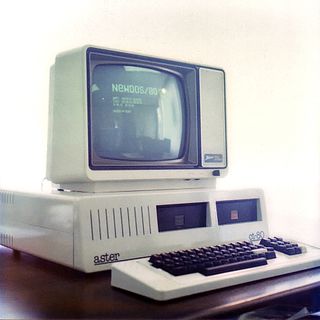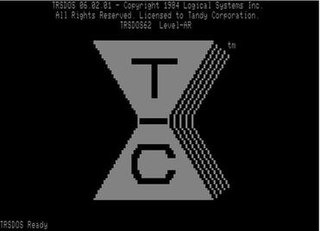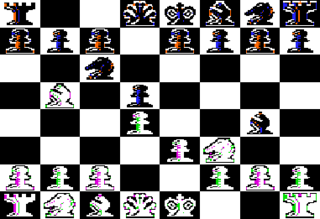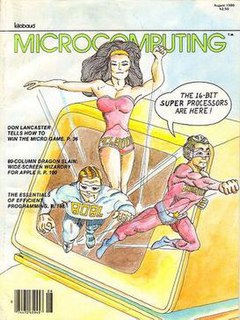Related Research Articles

The Aster CT-80, an early (1982) home/personal computer developed by the small Dutch company MCP, was sold in its first incarnation as a kit for hobbyists. Later it was sold ready to use. It consisted of several Eurocard PCB's with DIN 41612 connectors, and a backplane all based on a 19-inch rack configuration. It was the first commercially available Dutch personal/home computer. The Aster computer could use the software written for the popular Tandy TRS-80 computer while fixing many of the problems of that computer, but it could also run CP/M software, with a big amount of free memory Transient Program Area, (TPA) and a full 80×25 display, and it could be used as a Videotext terminal. Although the Aster was a clone of the TRS-80 Model I it was in fact more compatible with the TRS-80 Model III, and ran all the software of these systems including games. It also had a built in speaker which was compatible with such games software.

The TRS-80 Micro Computer System is a desktop microcomputer launched in 1977 and sold by Tandy Corporation through their RadioShack stores. The name is an abbreviation of Tandy/RadioShack, Z80 microprocessor. It is one of the earliest mass-produced and mass-marketed retail home computers.

The RadioShack TRS-80 Color Computer is a line of home computers based on the Motorola 6809 processor. The Tandy Color Computer line started in 1980 with what is now called the CoCo 1 and ended in 1991 with the more powerful CoCo 3. All three CoCo models maintained a high level of software and hardware compatibility, with few programs written for the older model being unable to run on the newer ones.

VisiCalc was the first spreadsheet computer program for personal computers, originally released for the Apple II by VisiCorp. It is often considered the application that turned the microcomputer from a hobby for computer enthusiasts into a serious business tool, prompting IBM to introduce the IBM PC two years later. VisiCalc is considered the Apple II's killer app. It sold over 700,000 copies in six years, and as many as 1 million copies over its history.

Li-Chen Wang is an American computer engineer, best known for his Palo Alto Tiny BASIC for Intel 8080-based microcomputers. He was a member of the Homebrew Computer Club and made significant contributions to the software for early microcomputer systems from Tandy Corporation and Cromemco.
Microsoft BASIC is the foundation software product of the Microsoft company. It first appeared in 1975 as Altair BASIC, which was the first version of BASIC published by Microsoft as well as the first high-level programming language available for the Altair 8800 microcomputer.

Scott Adams is an American entrepreneur, computer programmer, and video game designer. He co-founded, with ex-wife Alexis, Adventure International in 1979. The company developed and published video games for home computers. The cornerstone products of Adventure International in its early years were the Adventure series of text adventures written by Adams.
The Tandy 2000 is a personal computer introduced by Radio Shack in September 1983 based on the 8 MHz Intel 80186 microprocessor running MS-DOS. By comparison, the IBM PC XT used the older 4.77 MHz 8088 processor, and the IBM PC AT would later use the newer 6 MHz Intel 80286. Due to the 16-bit-wide data bus and more efficient instruction decoding of the 80186, the Tandy 2000 ran significantly faster than other PC compatibles, and slightly faster than the PC AT. The Tandy 2000 was the company's first computer built around an Intel x86 series microprocessor; previous models used the Z80 and 68000 CPUs.

TRSDOS is the operating system for the Tandy TRS-80 line of 8-bit Zilog Z80 microcomputers that were sold through Radio Shack from 1977 through 1991. Tandy's manuals recommended that it be pronounced triss-doss. TRSDOS should not be confused with Tandy DOS, a version of MS-DOS licensed from Microsoft for Tandy's x86 line of personal computers (PCs).

Sargon is a line of chess-playing software for personal computers.

Microdeal was a British software company which operated during the 1980s and early 1990s from its base at Truro Road in the town of St Austell, Cornwall. The company, founded by John Symes was one of the major producers of games and other software for the 8-bit home computers of the time, in particular the Dragon 32 and the similar Tandy TRS-80 Color Computer ("CoCo").

Video Genie is a discontinued series of computers produced by Hong Kong-based manufacturer EACA during the early 1980s. Computers from the Video Genie line are mostly compatible with the Tandy TRS-80 Model I computers and can be considered a clone, although there are hardware and software differences.

Scripsit is a word processing application written for the Radio Shack TRS-80 line of computers. Versions were available for most if not all computers sold under the TRS-80 name, including the Color Computer and several pocket computer designs, as well as the Tandy version of the Xenix operating system. Some of these versions are tape-based and have no ability to read or write to disk.

Kilobaud Microcomputing was a magazine dedicated to the computer homebrew hobbyists from 1977 to 1983.
SoftSide is a defunct computer magazine, begun in October 1978 by Roger Robitaille and published by SoftSide Publications of Milford, New Hampshire.
William Barden Jr. is an author of books and articles on computer programming. Barden's writings mainly covered microcomputers, computer graphics and assembly language and BASIC programming. He was a contributing editor for The Rainbow magazine in which he wrote a monthly column called Barden's Buffer on low-level assembly language programming on the TRS-80 Color Computer. Some of his books were published under the name William T. Barden. He lives in Scottsdale, Arizona.

The TRS-80 Model II was a computer system launched by Tandy in October 1979, and targeted at the small-business market.
The TRS-80 Model 4 is the last Z80-based home computer family by Radio Shack, sold from April 1983 through autumn 1991.

Home computers were a class of microcomputers that entered the market in 1977 and became common during the 1980s. They were marketed to consumers as affordable and accessible computers that, for the first time, were intended for the use of a single nontechnical user. These computers were a distinct market segment that typically cost much less than business, scientific or engineering-oriented computers of the time such as the IBM PC, and were generally less powerful in terms of memory and expandability. However, a home computer often had better graphics and sound than contemporary business computers. Their most common uses were playing video games, but they were also regularly used for word processing, doing homework, and programming.
References
- 1 2 The Alternate Source, by Matthew Reed, trs-80.org
- ↑ TRS-80 Magazine: The Alternate Source Magazine, By Ira Goldklang's TRS-80 Revived Site, Collection of covers for all 19 issues
- ↑ The alternate source : programmer's journal, 102727610, Computer History Museum, Published articles and information relating to Tandy's TRS-80 Model I or Model III computers.